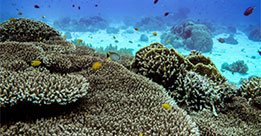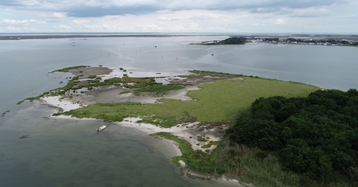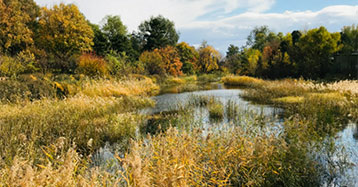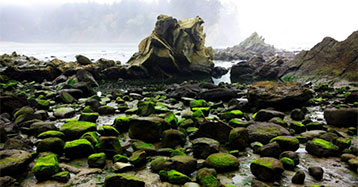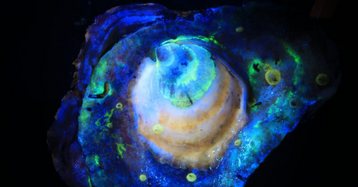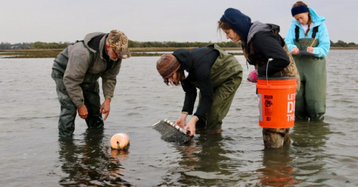Restoration
NCCOS research helps inform and drive strategic restoration and management of coastal habitats in order to enhance
ecosystem services. Our research provides the science, models, and tools required for evaluating performance and
restoration for a wide array of habitats and ecosystems including coral reefs, estuaries, and oysters. With natural and nature-based infrastructure, decisions about where and how to create and restore coastal habitats can influence ecosystem service
delivery and as a result, the resilience of coastal communities to inundation and other climate-related stressors. Our restoration science and products allow land managers, decision makers, and communities to make informed, data-driven decisions about how to best plan for, adapt to, and mitigate climate-enhanced threats to ecosystem services and coastal habitats.
Restoration in the Gulf of Mexico
Mesophotic and deep benthic communities are vast and complex ecosystems on the ocean floor that are foundational to the Gulf of Mexico food webs. Mesophotic benthic communities reside at water depths where light levels are low. These habitats support many species of corals and associated animals, including fish, anemones, sponges, and sea cucumbers. Deep benthic communities are found where there is no light. These species provide shelter and food for many animals, including starfish, sea urchins, fish, and crabs. Deep-sea corals are slow growing and can live for over 1,000 years. We collaborate on a variety of projects to better understand and restore these ecosystems affected by the 2010 Deepwater Horizon oil spill. These projects focus on seafloor mapping, ground-truthing, habitat modeling, and coral propagation. The overarching goal is to improve our understanding, inform better management, and ensure resiliency of mesophotic and deep benthic communities.
Coral Restoration Science
NCCOS works closely with NOAA's Office of Habitat Conservation’s Restoration Center and National Marine Sanctuaries, and U.S. states and territories to inform coral restoration design, implementation, and planning, and to evaluate restoration success. Our activities include developing models to evaluate reef resilience and forecast restoration-related changes in wave energy and inundation, building habitat maps to identify sites for restoration, acquiring, and analyzing large area imaging using photogrammetry, and artificial intelligence/machine learning.
Coastal Restoration: Climate Reliance Science
Coastal storms, flooding, and rising seas combined with loss of habitat and biodiversity threaten coastal communities, livelihoods, and ecosystems. Nature-based solutions involve the intentional use of natural habitats—beaches, dunes, islands, marshes, mangroves, and coral and oyster reefs—either alone or in combination with traditional gray infrastructure—like cement walls buried inside of sand dunes—to reduce risks to coastal hazards and deliver multiple environmental and socio-economic benefits. NCCOS works with natural resource managers, communities, and other coastal decision makers to develop tools, techniques, models, and guidance on how, where and when to best employ nature-based solutions. NCCOS assess the potential for using nature-based solutions to mitigate the effects of climate change and maintain and restore the area’s biodiversity and natural beauty.
Oyster Restoration Science
About 65 percent of U.S. estuaries and coastal waterbodies have moderate to high levels of nutrient-related degradation due to human activities, including burning fossil fuels, fertilizing farms and lawns, and concentrated animal feed lots. Oyster aquaculture, and other bivalve shellfish (clams, mussels), can improve water quality because their filter-feeding action removes nutrient-laden particles (algae and detritus) from the water. The inclusion of oyster-based removal of nutrients in a comprehensive nutrient management program can increase the success of management while also providing a domestic and sustainable source of seafood. Within the first designated oyster sanctuary in Maryland, NCCOS provides near real time water quality data and video streaming of a demonstration oyster restoration reef. These tools allow viewers to see a microcosm of large-scale ongoing oyster restoration in the Chesapeake Bay in a way that is personal, visual, and impactful. Researchers can use the tools to quantitatively evaluate numerous research objectives.
Featured Stories
 Official websites use .gov
A .gov website belongs to an official government organization in the United States.
Official websites use .gov
A .gov website belongs to an official government organization in the United States. Secure .gov websites use HTTPS
A lock or https:// means you’ve safely connected to the .gov website. Share sensitive information only on official, secure websites.
Secure .gov websites use HTTPS
A lock or https:// means you’ve safely connected to the .gov website. Share sensitive information only on official, secure websites.


